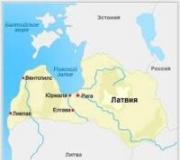Plasterboard for the ceiling - choosing the right material. How thick are plasterboard sheets needed for the ceiling? How thick should I use plasterboard for the ceiling?
In repairs, it is very important not only to be able to handle the tool, but also to know the features building materials. Do you know what type of plasterboard is needed for the ceiling? How many exist? various types GKL?
In this article we will look at each of them and describe the advantages and disadvantages of them.
GKL, GKLO and GKLV: the main difference between them is the color of the outer fabric and markings
Types of drywall
Drywall has gained wide popularity due to its practicality and low cost. However, not many people do not know that there are several types of gypsum boards, which differ not only in thickness, but also in their features and areas of application.
Ordinary plasterboard sheet
- Suitable for cladding residential premises, as partitions, walls and ceilings. Also used for office and industrial premises.
- Externally painted gray. It is very rare to find other colors.
- It has a light weight, since the thickness of the sheets is only from 8 to 10 mm. Although there are thicker sheets of about 16 mm, they are practically not used for finishing residential premises.
- Eco-friendly - safe for others.
Standard sheet sizes: 2500 and 1250 mm, length and width respectively.

This type of drywall is quite cheap, as it is not endowed with additional properties. You can easily build from it multi-level ceilings, combine them with various elements lighting. It can also be easily decorated: wallpaper, paint and plaster.
Fireproof plasterboard
- Suitable for finishing rooms with increased requirements fire safety: storage facilities, archives, ventilation shafts, production facilities.
- GKLO may meet, like gray, and with a pink coating.
- The thickness of plasterboard for ceilings with fire-resistant additives ranges from 9 mm to 12 mm. However, it is better to purchase thinner material; 12 mm sheets have increased strength and heaviness - they are used for wall decoration.
It would also be correct to sheathe living quarters with fire-resistant plasterboard in country houses: allows you to reduce the speed of fire spread throughout the apartment and room.
Moisture-resistant drywall
- The composition includes antifungal substances and silicone particles that prevent swelling of the material. Even high humidity in rooms, for example, in the bathroom, is not scary.
Note!
In combination with other materials that are also resistant to high humidity, the best results can be achieved.
In saunas, walls and ceilings are often built from gypsum plasterboard, after which they are covered with moisture-resistant paint or ceramic tiles.
- Dimensions are not standard, you can customize them optimal sizes and thickness, while not heavily loading the ceiling.
- It has a greenish surface and is usually marked in blue.
Do not forget that it is the colored surface that is the front side, which should be mounted outward.
In some rooms, for example, the same archives where valuable papers are kept, it is important to protect the contents from both fire and water. Therefore, you can use both GKLV and GKLO.
However, drywall differs not only in properties and areas of application. Several other types of edges can be distinguished.
Ceiling plasterboard calculator
A simple calculator looks like this:
Types of edges (edges) of sheets

- Straight (flat) edge - this option is suitable for repairs without sealing joints and ends.
- Semicircular, thinned and rounded edges - the ends are subject to subsequent pasting and putty.
- Beveled edges are subject to subsequent treatment with putty. This option is suitable for emphasizing longitudinal lines.
Each type is good in its own way, however, plasterboard with a smooth edge is most often used. And in construction stores there are several times more such materials.
Related articles:
Features of working with gypsum boards
Now that you know everything existing species plasterboard sheets, you should understand a few basic points regarding the work process.
Preparing to apply putty
After the drywall has been installed on the metal profile, all joints and screws should be sealed with putty, but before that:
- The entire surface is cleaned of dust; if possible, it is advisable to use sandpaper to remove excess roughness.
- After which the drywall is primed with a roller.

- You need to wait until the primer has completely dried and then begin applying the putty to the plasterboard ceiling.

Adviсe:
For better effect the surface must be primed again.
To ensure that the putty lays evenly, the joints of the sheets are glued masking tape. Once the solution has dried, the tape should be removed.
Use fine-grit sandpaper.
Painting drywall
GCR can be painted only after the procedures described in the previous section have been carried out.
Important!
Without putty, no paint, even in several layers, can last you long.
- Matte paints are suitable for surfaces that have minor defects and unevenness.
- Glossy paints look better on perfectly smooth surfaces.
You can apply paint with anything, but a ceiling that was painted using a spray gun and a roller will look more impressive.

Wallpaper for drywall
- You can glue any wallpaper onto the gypsum board surface: thick vinyl, non-woven and thin glass wallpaper.
- Be sure to pre-treat the drywall with a primer.
Advice!
Choose a primer mixture deep penetration, for example, on an acrylic base.
Today, no one can specifically answer the question of what kind of plasterboard should be used for ceilings. To choose correctly suitable look and to understand what the thickness of plasterboard for the ceiling should be, you need to take into account many factors that have great importance during repairs.
Types of ceiling plasterboard
There are three main types of gypsum boards: ordinary sheet, as well as moisture-resistant and fire-resistant. Let's look at each of them:
- Ordinary plasterboard sheet. Most often, the cladding is done precisely ordinary leaf GCR, since it meets all the required parameters and is almost universal. It is used not only in everyday life, but also in office premises. This variety has its own characteristics, such as: gray color and blue markings. The thickness of the sheet depends mainly on the manufacturer itself. The average size ranges from 8 to 9.5 mm. But most often, a material equal to 12.5 mm is used for ceiling cladding. This thickness has its advantages. First, thin ceiling plasterboard is easy to install. Secondly, due to its light weight, general design will have less weight. This type made with environmentally friendly pure materials, therefore does not contain substances harmful to human body. Since this is the most common type, it is accordingly very accessible and inexpensive. But despite its simplicity, it is very practical. With an ordinary gypsum board sheet you can easily install various items lighting, such as: light bulbs, LEDs, chandeliers, build multi-level structures, fortunately the dimensions of the sheet allow this.
- Fire resistant. The main feature of such materials can be understood by the name. These are sheets with a high level of durability and resistance to high temperatures. All this is thanks to the chemicals that are added to the composition. As a rule, it is used in places where there is a high level of fire safety: ventilation shafts, production facilities, archive rooms, storage facilities and many others. This kind of hanging cardboard is gray in color with red markings; you can also find plasterboard sheets Pink colour. You can choose a fire-resistant type, such as what type of plasterboard is needed for the ceiling, depending on the weight of the structure. Since the sheets have different parameters weight and thickness, it will not be difficult to choose what you need. By installing fire-resistant sheets in your country house, home, business or office, you can increase the level of safety of the premises. They do not allow the fire to quickly spread throughout the room, and even if there is a fire, the epicenter of the flame can be quickly extinguished.
- Moisture-resistant ceiling sheet. This material contains chemical substances, which resist the appearance of fungus, as well as silicone, which is resistant to high levels of moisture. The layer of moisture-resistant gypsum boards is on average 12.5 cm. Typically, moisture-resistant material is used in rooms such as the kitchen, bathroom, toilet, because it is in these places that there is high level moisture. Like other types, moisture-resistant has its own colors. In this case, it is light green with blue markings.
Having figured out what kind of plasterboard for the ceiling you need, you can’t help but highlight one more important point. In addition to the main features, this material is also distinguished by the type of edge.
Types of material by edge type

There are several various types edges:
- straight edge is used in dry installation. It is used in multi-layer ceiling structures as an inner layer;
- the thinned edge after installation is provided by gluing with reinforced tape or puttying;
- the rounded edge is used when sealing joints with putty without the use of reinforced tape;
- semicircular and refined edge. After its installation, the use of both putty and reinforced tape is required.
Most often, a thinned edge and a semicircular edge are used, since, thanks to such materials for plasterboard coverings, it is possible to seal the joints as evenly and accurately as possible, almost perfectly.
Before installing plasterboard sheets, you need to carefully prepare the room. After gypsum board for the surface required thickness was attached to metal profiles seal all joints and screws using regular putty.
On a note: But before installation, thoroughly clean the surface from various irregularities, roughness and other defects that may interfere with installation.
You can level the walls and ceiling using regular sandpaper. Next, treat the surface with a primer using a construction roller. After the primer has dried, you can safely putty.
So, all types of gypsum boards, their characteristics and features were considered. It was also described which of them are used most often in repairs. The builder can only choose which drywall to use. These descriptions and tips will help you make a high-quality ceiling installation.
Video on the topic
The concept of “ceiling plasterboard” as such does not exist among the manufacturers of this material. Nevertheless, from its varieties you can actually choose several options, in one case or another suitable for finishing the ceiling.
What is the difference between plasterboard suitable for ceilings and the usual so-called “wall”, what features does a fire-resistant and water-resistant sheet have and what should be the optimal thickness of plasterboard for ceiling structure? More on this below.
Classic plasterboard sheet - blue marking
When asked which drywall is best to use for the ceiling in a residential area without extreme conditions operation the answer is simple - ordinary. Standard gypsum plasterboards are suitable for covering ceilings in an apartment, house, office or change house, if the temperature and humidity there remain at the same stable level, without exceeding or falling below the norm.
Visually, such sheets are easy to distinguish by their gray color and blue markings. U different manufacturers The size of the ceiling plasterboard is different. For example, the thickness ranges from 6.5-24 mm. But this does not mean that any of the options is suitable for the ceiling. The ideal thickness is from 8 to 9.5 mm and no more, this is important to consider.
A relatively thin plasterboard sheet for the ceiling is chosen to simplify installation and reduce the load on the base, lightening the overall weight of the finished structure.
Standard sheet dimensions are 120 cmX250 (300) cm and are unchanged.
What is fire resistant drywall sheet and when is it appropriate?
Flame resistant sheets may be considered as an option finishing material for the ceiling. Its main feature is its increased resistance to fire, so it makes sense to choose this material when decorating the ceiling in specialized rooms:
- attics;
- libraries;
- archives;
- warehouses, etc.
Fire-resistant plasterboard is ideal as a means to improve fire safety. For residential premises, this option is not the most convenient. The sheets have a characteristic gray surface and red or pink markings. But the thickness of plasterboard for a fire-resistant ceiling can be different, but you should choose the least heavy (thin) sheets to reduce total mass finished design.

Moisture-resistant gypsum boards: features
Moisture-resistant drywall unlike regular or fire-resistant, it includes silicone granules and anti-fungal components that prevent moisture and allow you to keep the canvas in perfect shape even with high levels of humidity in the room. The sheets are based on impregnated cardboard.
To enhance the properties of the sheet, with front side it is additionally finished with moisture-resistant materials, for example, waterproof paint, tiles or PVC panels.
Just like previous types, the size of plasterboard for a waterproof ceiling may vary depending on the manufacturer. It's about primarily about the thickness with relatively unchanged width and length of the sheets.
To the question of whether moisture-resistant plasterboard can be used on the ceiling in residential premises, the answer is clear - it can and should. For finishing the kitchen, bathroom and other rooms where there is a risk of flooding from above, such a ceiling will be the best solution.

To protect the contents of the room, waterproof plasterboard is no worse than stretched PVC sheeting. Yes, in the event of a flood, the finishing cladding will most likely lose its previous appearance, requiring replacement. But the base of the ceiling - plasterboard - will prevent flooding of the room, moreover, it will remain suitable after drying.
A distinctive feature of moisture resistant plasterboard sheet- green surface tint and blue markings.
In rooms that need to increase fire resistance and moisture resistance at the same time, it is better to use special ceiling sheets that combine the properties of the two options.
What kind of gypsum board edges are there and what do they affect?
Having figured out how to choose plasterboard for the ceiling, taking into account the basic properties (fire resistance, water resistance), you can move on to analyzing the options depending on the type of edge. There are sheets with the following edges:
- direct (PC);
- rounded (ZK);
- thinned (UK);
- semicircular (SCC).

Sheet with PC implies “dry” installation without the need for laying joints. Suitable for constructing multilayer structures as an intermediate layer. Sheets with CC are used for finishing the ceiling with reinforcing tape. Drywall with a seal is suitable when you plan to putty a joint without reinforcing tape. Sheets with PKK are used for installation of structures, followed by puttying and taping the joint.
The last two material options are used more often than others, as they guarantee perfectly smooth sealing of seams.
Drywall is one of the most used building materials. It has become a complete replacement for plaster, while being much simpler and easier to install.
The process of finishing surfaces during repairs involves the use of different types drywall, differing in size from each other. To finish the ceiling, you need to know the dimensions of the ceiling plasterboard in order to accurately determine and purchase the material suitable for cladding.
Differences between ceiling plasterboard and other types in size
Determining the size of drywall is possible using the following standard:
- All types of gypsum boards, including ceiling ones, are 1.2 meters wide;
- Sheets 2-3.6 meters long;
- Plasterboard sheet 6.5-12.5 meters thick.

Dimensions of different types of drywall
For determining the desired type drywall, you need to know the dimensions of the sheets that are intended for various surfaces, including the dimensions of the ceiling plasterboard:

Regarding the length and width of plasterboard sheets for different needs, these parameters are the same for all types of material and are often produced in the following variations:
- 3000x1200 mm;
- 2500x1200 mm;
- 2000x1200 mm.
Types of ceiling plasterboard
There is also its own classification of ceiling plasterboard:
- Conventional ceiling plasterboard used for finishing rooms with normal humidity and fire safety. This material It has minimum thickness, amounting to 8-9.5 millimeters from various manufacturers.
- Moisture-resistant plasterboard is not specifically designed for ceilings with low levels of water absorption, but more subtle modifications of the usual moisture-resistant material can be used to finish such surfaces. Similar sheets are used in the process of finishing rooms with high and increased level humidity, such as the kitchen and bathroom.
- Fire-resistant plasterboard boards are also universal, and regarding ceiling cladding, suitable sizes of ceiling plasterboard are also selected from modifications with a thickness of no more than 9 millimeters.
Calculation of the amount of plasterboard for the ceiling, depending on the dimensions of the sheets
For hanging single-level ceiling To calculate the material, you need to start by measuring the width and length of the room.
Let's make an approximate calculation for a standard living room 5.6x3.1 meters.
If there are deviations, then it is necessary to rely on large values so that there is enough material.
IN in this example it is advisable to choose ceiling plasterboard standard sizes 1.2x2.5 meters.
They allow the ceiling to be finished with plasterboard in accordance with technology, i.e. in a spaced manner, while using sheet sizes as efficiently as possible - with fewer scraps.
The sheets are placed lengthwise across the room; at the same time, some sheets are cut in half and adjusted to required sizes. During the installation of the last row, sections of sheets are also cut in width from 1.2 to 0.8 meters.
As a result, not taking into account the reserve in case of defects, eight sheets of standard dimensions are needed to cover the ceiling with plasterboard.

When planning home renovations, they answer the questions: what material is best to use, what thickness of plasterboard for the ceiling is suitable, how much to buy. Even minor details are taken into account.
In the current building materials market, manufacturers offer consumers to divide drywall according to its properties and scope of application.
Different types of material depending on composition
- Ordinary (gypsum plasterboard). This type consists of plaster and sheets of thick cardboard. It is mostly gray in color and weighs little, which is convenient when working at elevated positions. GCR has a low cost because there are no additional properties. It is used in rooms where there is no high humidity. Typically the sheet is used for wall cladding, frame ceiling, construction of partitions. It is easily subject to further processing, such as wallpapering. GCR is made from environmentally friendly materials, therefore it is completely safe for people.
- Fire resistant (GKLO). This material can withstand a high degree of heat. This feature suggests that this type drywall is installed near fireplaces or other fire-hazardous structures. With its help, additional partitions are erected in the room, walls and ceilings are decorated country houses to reduce the speed of advancement of open fire.
- Moisture resistant (GKLV). The peculiarity of this type of drywall is that its structure contains specific elements that make it possible to reduce the threshold for water absorption. Thanks to this, the material does not lose its appearance, does not swell. It has been noticed that mold and mildew do not form on such drywall. It is intended for covering rooms with high levels of humidity. For example, a bathroom or in a country house where there is dampness.
- Fire and moisture resistant (GKLVO). This is the optimal type of material, since it is not afraid of exposure to either moisture or temperature.
 Various thickness material
Various thickness material Types of drywall by size, which one and where to use it
If speak about physical properties drywall, then one sheet can cover three square meters surface and weighs approximately 30 kg.
Depending on the thickness of the material, there are three categories:
- Arched. The thinnest material, its thickness is 6.5 mm. It bends and fulfills the designer’s original ideas, decorating doorways and niches;
- Ceiling. Plasterboard of medium thickness (from 8 to 9.5 mm). This sheet of material is lighter than conventional gypsum board; it is used during installation suspended ceiling.
- Wall. Thickness – up to 12.5 mm. This material is used for finishing walls, niches or partitions.
Ceiling gypsum board – economical option, because it has a simple and lightweight composition.
As can be seen from the information above, before proceeding with the installation of a plasterboard ceiling, it is determined which material to choose and which problem to solve.
How to calculate the consumption of plasterboard for the ceiling
The main mistake of novice builders is that they select the wrong sizes of drywall sheets. Because of this, many seams are formed. For correct installation of the ceiling, the master will select optimal length material and place it on the surface according to the rules. To do this you will need several sizes.
 Material calculation diagram for a suspended ceiling
Material calculation diagram for a suspended ceiling Beginners are advised to draw a diagram of the planes on which drywall will later be installed, as shown in the figure above. It is better to do this on a sheet of paper in a box to select the required scale. By graphically placing the material, you can see what size is needed and how much drywall will be spent.
If there is no time for such calculations, then they purchase material based on total area surfaces, adding up to 20% “in reserve”.
It is taken into account that if the ceiling is 280 cm wide, then best option– use 300 cm sheet. A mistake in this case would be to install 250 cm of material with the missing 30 cm attached to it. This method will reduce the number of profiles used, securely fix the structure, and save time allotted for work. The ceiling will look aesthetically pleasing due to the absence of many seams and joints.
 Installation of conventional plasterboard sheet
Installation of conventional plasterboard sheet Important aspects when installing gypsum boards
Drywall is installed in two ways:
- Glue directly to the surface. A special glue containing gypsum is used. In this case, the plane is leveled to a smooth state without differences.
- If there are unevenness or other defects on the ceiling, the gypsum board is mounted on a metal or wooden frame. And the drywall is attached to it with screws.
Sometimes it is necessary to make a bend from a plasterboard sheet. To do this, it is pre-moistened, fixed to the template and left to dry. In such cases, use a special roller with metal needles. By passing it along the surface of the gypsum plasterboard, small holes, through which moisture passes better.
It should be noted that the joints of the sheets fall on the frame bar so that cracks do not form in this place.
After installation, the drywall is cleaned of dirt, dust and excessive roughness. Then it is covered with a primer, after which it dries, either wallpaper is pasted or plaster is applied.
In contact with




